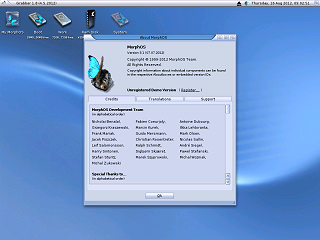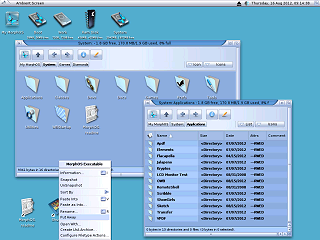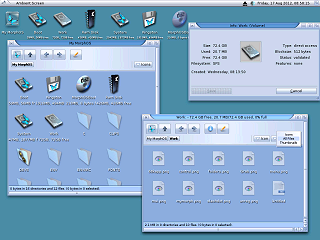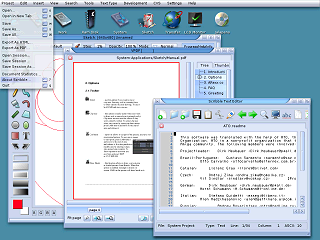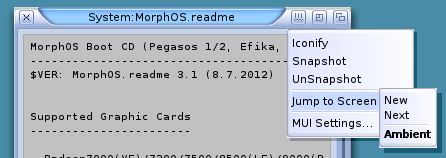|
|
Location: GUIs >
Amiga >
MorphOS 3.1 Screenshots 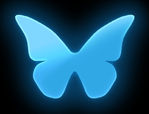 MorphOS is a commercial product that must be purchased for regular use. The CD image is freely downloadble, but may only be used for 30 minutes at a time until it is registered. The CD may be run as a live CD or installed to a hard drive.
"Ambient" is the name of the desktop and file manager in MorphOS. "MUI" (Magic User Interface) is the name of the widget control library.
Drive icons appear on the desktop, but these are also "shortcuts" and can be put away. Their actual location is in the "My MorphOS" folder. Files and folders on the system are visibly accessible through a file browser. It can view folders as a large icons or a detailed list. You can copy files between folders using drag and drop, however there is no "trash" icon. Folders are also referred to as "drawers", but are visibly represented by folders. Folders with older AmigaOS programs will likely use a drawer image as its custom folder icon. Programs are launched by browsing the file system. There is no central program launcher or "Start" type menu. There is also no facility for creating new documents, requiring you to launch applications first and then save files. The information bar at the top doubles as a global menu. Oddly, but like the original Amiga, the global menu only appears when you right-click on on the menu bar.
An oddity of this file browser is that by default, folder and file icons are not visible unless there is an "info" file associated with it. An "info" file contains a custom icon and icon position information. This mimics how AmigaOS handled file icon information, but the bundled applications behave more like modern application and do not create extra "info" files. The result is that to see your files you must repeatedly select to show "all files" in each folder window.
Although some documentation files are included, there is no application help system.
The default window management is a little different, and again mimics the original AmigaOS. The "X" button is a simple close button. The "Popup" button contains a sub menu with windowing commands.
The "Zoom" button toggles the window between a larger and smaller size,
but does not act like a "maximize" button.
You can drag windows around the screen by the title bar. MorphOS does not permit moving any edge of a window beyond the edge of the screen.
Control panel applets open in the same window, but there is no "back" button or navigation hierarchy. The applets also differ from most UIs in that they have "Save", "Use", and "Cancel" buttons. Settings are not saved when the window is closed or the "Use" button is pressed, only when Save is explicitly clicked. Although I didn't have anything to try it with off hand, MorphOS appears to support printing to a number of different printers over serial, parallel, USB, or LPR over TCP/IP. |
